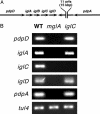MglA regulates transcription of virulence factors necessary for Francisella tularensis intraamoebae and intramacrophage survival
- PMID: 15010524
- PMCID: PMC384726
- DOI: 10.1073/pnas.0307690101
MglA regulates transcription of virulence factors necessary for Francisella tularensis intraamoebae and intramacrophage survival
Abstract
Francisella tularensis is able to survive and grow within macrophages, a trait that contributes to pathogenesis. Several genes have been identified that are important for intramacrophage survival, including mglA and iglC. F. tularensis is also able to survive within amoebae. It is shown here that F. tularensis mglA and iglC mutant strains are not only defective for survival and replication within the macrophage-like cell line J774, but also within Acanthamoebae castellanii. Moreover, these strains are highly attenuated for virulence in mice, suggesting that a common mechanism underlies intramacrophage and intraamoebae survival and virulence. A 2D gel analysis of cell extracts of wild-type and mglA mutant strains revealed that at least seven prominent proteins were at low levels in the mglA mutant, and one MglA-regulated protein was identified as the IglC protein. RT-PCR analysis demonstrated reduced transcription of iglC and several other known and suspected virulence genes in the mglA mutant. Thus, MglA regulates the transcription of virulence factors of F. tularensis that contribute to intramacrophage and intraamoebae survival.
Figures



References
Publication types
MeSH terms
Substances
Grants and funding
LinkOut - more resources
Full Text Sources
Other Literature Sources
Molecular Biology Databases

